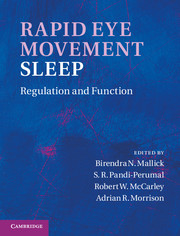Book contents
- Frontmatter
- Contents
- Contributors
- Preface
- Acknowledgments
- Organization
- Section I Historical context
- Section II General biology
- Section III Neuronal regulation
- Section IV Neuroanatomy and neurochemistry
- Section V Functional significance
- Section VI Disturbance in the REM sleep-generating mechanism
- 40 Narcolepsy and REM sleep
- 41 REM sleep and dreams: relationship to anxiety, psychosomatic, and behavioral disorders
- 42 REM sleep and emotion regulation
- 43 Neural modeling for cooperative/competitive regulation of REM sleep with NREM sleep and wakefulness
- 44 The selective mood-regulatory theory of dreaming: an adaptive, assimilative, and experimentally based theory of dreaming
- Index
- Plate section
- References
40 - Narcolepsy and REM sleep
from Section VI - Disturbance in the REM sleep-generating mechanism
Published online by Cambridge University Press: 07 September 2011
- Frontmatter
- Contents
- Contributors
- Preface
- Acknowledgments
- Organization
- Section I Historical context
- Section II General biology
- Section III Neuronal regulation
- Section IV Neuroanatomy and neurochemistry
- Section V Functional significance
- Section VI Disturbance in the REM sleep-generating mechanism
- 40 Narcolepsy and REM sleep
- 41 REM sleep and dreams: relationship to anxiety, psychosomatic, and behavioral disorders
- 42 REM sleep and emotion regulation
- 43 Neural modeling for cooperative/competitive regulation of REM sleep with NREM sleep and wakefulness
- 44 The selective mood-regulatory theory of dreaming: an adaptive, assimilative, and experimentally based theory of dreaming
- Index
- Plate section
- References
Summary
Summary
Narcolepsy is characterized by excessive daytime sleepiness (EDS), cataplexy, and/or other dissociated manifestations of rapid eye movement (REM) sleep (hypnagogic hallucinations and sleep paralysis).
The major pathophysiology of human narcolepsy has been recently elucidated based on the discovery of narcolepsy genes in animals. Using forward (i.e., positional cloning in canine narcolepsy) and reverse (i.e., mouse gene knock-out) genetics, the genes involved in the pathogenesis of narcolepsy (hypocretin/orexin ligand and its receptor) in animals have been identified. Hypocretins/orexins are novel hypothalamic neuropeptides also involved in various hypothalamic functions such as energy homeostasis and neuroendocrine functions. Mutations in hypocretin-related genes are rare in humans, but hypocretin-ligand deficiency is found in many narcolepsy–cataplexy cases.
After the discovery of sleep-onset REM periods (SOREMs) in narcolepsy, narcolepsy has often been referred as an “REM-sleep disorder.” REM sleep can intrude in active wake or at sleep onset, resulting in cataplexy, sleep paralysis, and hypnagogic hallucinations; these three symptoms are often categorized as “dissociated manifestations of REM sleep.” Although cataplexy and REM-sleep abnormalities are the hallmarks of narcolepsy and these symptoms differentiated narcolepsy from other types of hypersomnia, it is now conceived that impairments of hypocretin neurotransmission cause both the EDS (possibly due to the sleep–wake fragmentation) and REM-sleep abnormalities in narcolepsy; it is impossible to discuss these mechanisms independently.
While sleep paralysis and hypnagogic hallucinations exist in other sleep disorders (such as obstructive sleep apnea) and even in normal subjects, since cataplexy is tightly associated with hypocretin impairments, cataplexy is likely to be pathophysiologically distinct from other dissociated manifestations of REM sleep.
In this review, the clinical and pathophysiological aspects of sleep abnormalities in narcolepsy, with a special focus on those of REM sleep-related symptoms, are discussed.
- Type
- Chapter
- Information
- Rapid Eye Movement SleepRegulation and Function, pp. 403 - 416Publisher: Cambridge University PressPrint publication year: 2011



